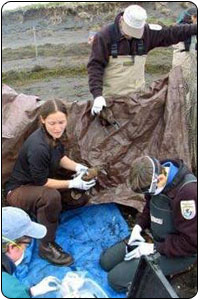 |
| The U.S. Fish and Wildlife Service and U.S. Geological Survey work with federal, state and local partners to monitor and test migratory birds in a comprehensive program that will provide an early warning to the agriculture, public health, and wildlife communities if migratory birds are found infected with the Asian strain of H5N1 or other highly pathogenic avian influenza. |
The U.S. Department of the Interior's initiatives on Highly Pathogenic Avian Influenza (HPAI) and pandemic preparedness and response are an integral part of the President's National Strategy for Pandemic Influenza.
DOI is involved with monitoring and testing wild migratory birds for HPAI because the Department has authority for managing and protecting wildlife, including migratory birds, under various laws and treaties. In addition, Interior has responsibility for protecting the health of employees and visitors on more than 500 million acres of federal lands across the nation. Interior also has a major responsibility to provide the public timely, accurate and consistent information about avian influenza developments as they relate to Interior programs and activities.
Interior, the U.S. Department of Agriculture and a broad array of state, local and non-government partners are conducting expanded capture, sampling and testing programs to detect the highly pathogenic H5N1 avian influenza virus or other HPAI viruses in North American migratory birds.
These efforts are guided by a coordinated and comprehensive interagency program that will provide an early warning to the agriculture, public health, and wildlife communities if migratory birds are found infected with
HPAI.
This early detection plan prioritizes survey efforts to focus on Alaska,
elsewhere in the Pacific flyway, followed by the Central flyway, Mississippi flyway, and Atlantic flyway.
This plan was developed by waterfowl biologists, wildlife disease biologists, veterinarians, and epidemiologists from the U.S. Departments of Agriculture, Interior and Health and Human Services, along with the International Association of Fish and Wildlife Agencies, National Association of Public Health Veterinarians and the state of Alaska Department of Fish and Game. This program involves collaboration among the USGS, U.S. Fish and Wildlife Service, U.S. Department of Agriculture, state agencies (including Hawaii and U.S. Pacific Territories), and others.
In partnership with the State of Alaska, the FWS, and the USGS, biologists have been strategically sampling migratory birds for highly pathogenic H5N1 in the Pacific Flyway since August 2005, in places where birds that regularly migrate between Asia and North America are known to congregate and to nest. The USGS/FWS project complements the efforts of biologists from USDA, Alaska Museum, and University of Alaska - Fairbanks; this project is coordinated among the groups to maximize sampling of different species of wild birds at different locations, avoiding duplication of effort. Interior, in cooperation withe U.S. Department of Agriculture, national Flyway Councils and the state agencies also works to monitor wild birds for highly pathogenic H5N1 virus through cooperative agreements and projects in the Lower 48 States, Hawaii, U.S. Territories and Freely Associated States.
The Department also is carrying out plans and initiatives to protect its employees and visitors, including avian influenza informational campaigns, training programs and operational protocols for DOI facilities that could be affected by HPAI or pandemic influenza. The Department and its bureaus also are implementing communications plans and networks to inform the public about ongoing and future DOI activities regarding avian influenza and pandemic preparedness.
As Interior's primary science and research agency, the U.S. Geological Survey (USGS) has a long history of responding to wildlife disease emergencies and conducting wildlife disease investigations. The U.S. Fish and Wildlife Service has primary responsibility for managing the nation's wildlife. FWS administers the National Wildlife Refuge System, with many of its 545 refuges providing critical nesting, migration, and wintering habitat for waterfowl and other migratory birds. FWS also works with the U.S. Department of Agriculture (USDA) at major U.S. air and sea ports to regulate the importation of wild birds for the pet trade, research, and other purposes.
With 388 units in the National Park System, the National Park Service (www.nps.gov) has a key role in the management and health of wildlife on NPS lands and in protecting the health of its visitors. The NPS works to preserve, protect and manage biological resources and related ecosystem processes with efforts at the park unit, regional and national levels through the Biological Resource Management Division. The NPS helps protect visitors by hosting 32 commissioned officers of the U.S. Public health Service. en Español
Frequently Asked Questions About Avian and Pandemic Flu |